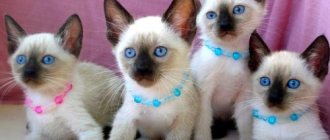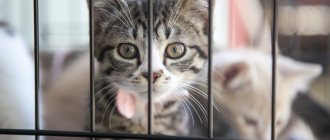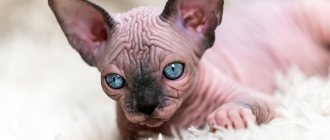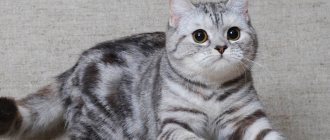Siamese kittens are cute and curious, like all babies. But these little blue-eyed lumps have a trait that from an early age distinguishes them from kittens of all other breeds: from birth it is a personality. If you are planning to get a Siamese kitten, try to find out as much as possible about it. This will greatly facilitate communication, education and care for him.
Description of the breed
Siamese cats are amazingly sophisticated creatures. Medium in size, flexible and graceful, they are distinguished by well-developed muscles and harmonious build.
The breed standard stipulates a head shape in the form of an equilateral triangle, large, elongated ears, slanted eyes, an elongated body, slender, dry limbs with collected paws in the shape of an oval and a thin flexible tail.
The Siamese's coat is short, soft, silky and lies close to the body. A contrast in the basic tone and markings is required, and the color of the fur on the face, ears, paws and tail must match. The back and sides should be slightly darker than the neck, chest and stomach.
Both the absence of points and weak contrast are considered unacceptable. Animals with knots and creases in the tail are also culled. This sign indicates degeneration due to inbreeding.
Eye color is supposed to be blue. Greenish tints are considered a deviation from the standard.
About the origin of the breed: history and legends
The homeland of Siamese cats is the Kingdom of Thailand. It was once called Siam. Local felinologists (specialists in the study of cats) say that the breed has been known for more than 600 years. However, outside the state they knew nothing about it until the last quarter of the 19th century. In ancient Siam, these cats were considered temple animals and were worshiped. Religious Siamese believed that graceful animals accompanied the souls of the dead to the afterlife.
Modern Siamese are lean and graceful
The Siamese cat managed to get into the biblical legend of Noah's Ark. According to legend, the first Siamese kitten was born thanks to the love of a beautiful lioness and a courageous male monkey. Therefore, the fruit of their love and its descendants are smart and dexterous like a monkey, and also fearless, like lions. By the way, there is some truth in this mythical story. Biologists believe that the Siamese breed was the result of crossing two species. But the primates did not participate in this. Domestic cats brought to Asia made love with local wild cats.
Blue-eyed cats lived in the royal palace and the chambers of the rich and noble people of Siam. At the end of the 19th century, they settled at the courts of European monarchs. The Siamese king decided to give several pairs of cats to his colleagues. In 1884, the first seals of an unprecedented breed arrived in London. From this time on, the triumphal march of the Siamese across Europe began.
Elegant cats were very fond of English queens and their loyal subjects. At the very first exhibition, the Siamese became the favorites and for a long time did not give primacy to others. At the very beginning of the 20th century, the “Siamese Cat Lovers Club” appeared in Great Britain, and the first breed standard was developed. It is significantly different from the modern one. The first standard color is a soft beige body and dark brown, almost black, markings (seal point). English breeders are still considered trendsetters in breeding this breed.
Later, the Siamese conquered other European countries, Russia, and then the United States. New “colors” have appeared: white-blue, cream-chocolate, white-lilac.
The new Siamese breed standards are very different from the previous ones
50 years later, the breed standards were revised: modern colors were legalized, the physique of the Siamese cat changed. The purebred animal has a narrow wedge-shaped head, decorated with wide-set large ears, a light and long body, and graceful paws.
Video: history and modernity of the Siamese breed
Character
The character of Siamese cats is often characterized by stubbornness and selfishness. This does not mean at all that they cannot become a devoted friend to a person. Just the opposite! Animals of this breed become very attached to their owner and literally run after him, reminiscent of small dogs in this way. And yet, for a Siamese, an owner is, first of all, a source of all kinds of benefits, and only then a friend and protector.
If there is only one cat in the house and everyone around her does nothing but caress her, admiring her intelligence and beauty, everything goes fine. But as soon as a competitor appears, be it a kitten or a puppy, the life of a new family member can turn into hell! There are often cases when you have to part with him in order to maintain peace and tranquility. There are exceptions if an older cat is introduced to a baby. Usually she calmly accepts him and subsequently friendship develops between the animals.
Interesting facts about the Siamese cat
- The color of their coat is determined not only by heredity. This breed has a special modifier gene that prevents the development of pigment in the fur, which leads to albinism.
- Siamese are considered one of the oldest cat breeds in the world.
- Legends say that in ancient times the first Siamese cats were tasked with guarding the royal cup. They looked at him with such intensity that their eyes crossed. For added security, the cats wrapped their tails around the cup, causing them to become permanently bent.
- Siamese cats have appeared in many Hollywood films.
Overall, this is the most affectionate cat breed you will find. She is very smart, obedient and friendly, and also loves and values human communication so much that she is even called a cat-dog.
Newborn kittens
Siamese cat kittens are born completely white, only their nose and paw pads are pink. Darkening of the coat can begin from two weeks of age, and one or another color is determined by the temperature in the room where the kitten is. In a very warm room, the main coat color will be milky white or cream, and the color of the markings will be chocolate. The cooler the apartment, the darker the color will be. Siamese kittens that are born and live outside (those that are trained to be mousecatchers in a barn or goat stall) after the first moult become dark brown, and their point color is almost black. The final color of a Siamese kitten is established only by ten months.
Taking the kitten home
If you have already found a suitable cat with kittens, you should take into account that premature deprivation of babies from maternal care has a bad effect on their psychological state. So, in this regard, we can strongly advise you not to adopt a kitten until it reaches one and a half months old. The best thing to do would be to wait even longer.
Fluffy babies of any breed, of course, do not easily tolerate a change in their usual environment. So, if a kitten in a new place immediately climbs into some distant secluded corner, where no one can get it, then this is quite normal.
And then you should not try to call it out, but you should place bowls with drinking water and food nearby, as well as cat litter.
Try not to make loud and sharp sounds at first, so that the baby does not get scared and realizes that the environment around him is completely safe with non-hostile inhabitants. After some time, usually an hour or two, the kitten’s curiosity and hunger will prevail, and it will leave its shelter.
Choosing a kitten
Cat or cat?
Having decided to purchase a Siamese kitten, the future owner often does not know who to choose: a cat or a cat. At two to three months, all kittens are equally charming. But childhood does not last long, and when the pet grows up, its belonging to one gender or another will appear before the owner in all its glory.
Most owners of Siamese cats believe that the males of this breed are much more beautiful than the females. One cannot but agree with this opinion. The Siamese cat has a more impressive size; its body proportions are slightly different than those of females: the body is shorter and the head is larger. Some people believe that keeping a male is not particularly difficult, unlike a female. At least you won’t have to think about where to place the kittens.
However, this is not even the point. The problem of cat marks and unwanted offspring can be solved by castration or sterilization. What will stay with an animal forever is its character.
The Siamese cat feels like a sovereign master in the apartment. He perceives the owners as servants who must fulfill his every whim. He is curious, active, loves to poke his nose everywhere, especially where he is not allowed. Often irritable and aggressive.
Cats of this breed have a much calmer, affectionate character. They become very attached to a person (most often this is the owner), and vigorously show their love and devotion. And the cleanliness of Siamese dogs is legendary!
Although there are no rules without exceptions.
Choice depending on color
After you have decided on the gender of your future pet, you need to decide what color you like.
Most often, when people think of a Siamese kitten, they think of the classic sealpoint: cream coat, dark markings and beautiful blue eyes. The image is truly captivating, but this color is by no means the only one. Bluepoint (snow-white coat color with blue-gray markings), redpoint (white background color and apricot or red markings), lilacpoint (silver coat with lilac-pink markings)… It’s easy to get confused! But there are other colors: chocolate point (an ivory coat with very dark, almost black markings), cinnamon point (ivory and brownish points), caramel point (an absolutely amazing, indescribable shade of coat with gray-pink points), tabbypoint (lovely solid-colored cats with striped markings), tortiepoint (a fantastic combination of calm background color and spotted points).
The eye color of Siamese cats depends on the color of the coat: the darker and more saturated the color of the animal, the brighter and deeper the blue will be.
There is an opinion (though not yet confirmed by anything other than the words of the owners) that cats of different colors have different personalities. For example, it is believed that the temperament of bluepoints is much softer and more pleasant than that of sealpoints or chocolate points.
Features of feeding and diet
Veterinarians recommend including dry food in the diet of Siamese cats. Unlike natural food, granules help eliminate plaque and prevent the development of tartar. The breed often suffers from gingivitis and periodontal disease, so additional care for the oral cavity will not be superfluous.
Among industrial foods there are lines designed specifically for Siamese. On the package you can find a table with guidelines for feeding a kitten or adult animal. All norms are calculated based on the weight and age of the cat. Additionally, a feeding cheat sheet is indicated, where dry food is combined with wet food (canned food or pouches).
Dry food is divided by age and breed. Medicinal feeds are produced separately and are recommended as dietary food for sick animals. When choosing food, check its class. Economy class products are made from low-quality raw materials. It is filled with “empty” calories and is fraught with health problems. Good food starts from premium.
When purchasing, people are often put off by the price tag and mistakenly believe that the best food is holistic. It is attractive due to its high protein content, but its excess is fraught with complications. If a cat has problems with the urinary system, then it needs a low-protein diet. Check with your veterinarian to see if holistic food can be given to your pet.
If you have enough free time to cook, you can try natural feeding. It includes:
- lean meat (turkey, rabbit, beef);
- offal (liver, tripe, heart);
- low-fat fermented milk products (cottage cheese, yogurt);
- a small amount of vegetables (carrots, cucumbers) and sprouted greens;
- cereals (rice, egg).
Meat and offal should make up 2/3 of the total diet. Twice a week they can be replaced with sea fish, but only after the approval of a veterinarian.
It's easiest with newborn kittens. The mother feeds them with breast milk for up to 2 months. As animals age, they develop lactose intolerance, so milk is removed from the diet. If there is a shortage of mother's milk or a large number of newborn kittens, they are transferred to artificial formula. Up to 1 month, babies are fed every 2 hours.
From 2-3 months, kittens are given their first complementary foods. It can include minced boiled beef and homemade cottage cheese, which is necessary for bone development. At this age, little Siamese are fed 6 times a day. From 4 months, the number of feedings is reduced to 4-5, and from 6 months – to 3. Until 1 year, meals are reduced to 2 times a day, and portion sizes are increased.
Care and maintenance
Features of caring for a kitten aged 1 month The kitten you want to buy should be at least two, and preferably three to four months old. At this age, kittens completely switch to normal food, are practically independent of their mother, are curious and very sociable. The baby will willingly make friends with you and the rest of the family.
If you get a kitten that is at least a month old, difficulties cannot be avoided. Such kids have great difficulty making contact. If there are small children in the family, it is advisable to completely protect the kitten from their attention. Absolutely everything scares him: large (as much as two meters!) distances, loud sounds, an unexpectedly chirping sparrow... The first days he can sit in the sofa or the pocket of an old bag, secretly getting out of there to grab a piece of food or go to the toilet. One person must take care of such a baby. You should not force him out of hiding and poke his muzzle into the food if he resists. The best thing you can do is leave him alone and quietly observe. Let your baby get comfortable. Only when the kitten stops hiding at every rustle can you begin to introduce him to the whole family.
Pregnancy and childbirth
Cats typically reach puberty at 8 months of age. But Siamese cats, which belong to the oriental type, enter this period earlier - at 4 - 5 months. The onset of sexual activity may be influenced by the time of birth of the animal. A woman born in the spring may demand a cat in the fall, and a woman born a little later will most likely begin to come into heat in the spring of next year. The ability to reproduce begins only at 10 months of age and continues until 8 years.
The average gestation period for Siamese cats is 65 days. Lambing that occurs before 60 days is considered premature. Kittens born at this time are considered non-viable. If labor does not begin on day 68, we can talk about post-term kittens, in which case you need to seek help from a veterinarian.
If the date of the tailed couple was successful, then in the first month the first changes in the appearance and behavior of the cat will become visible. At this time, there is a slight increase in weight. There may be loss of appetite and slight vomiting. After day 35, the cat’s tummy becomes rounded, the nipples turn pink and enlarge. There is an appetite and a desire to sleep longer. During this period, the cat’s life is almost no different from before, but too active games should be prohibited, although dosed activity is necessary. In the later stages, a pear-shaped tummy appears, and by placing your hand on it you can feel the kittens moving. 2 weeks before birth, the movements of the kittens in the womb are clearly visible when the tailed mother lies on her side. During this period, the animal's activity is significantly reduced. It is best to provide your cat with a cozy place to rest and not disturb her unnecessarily.
During pregnancy, the cat should feel comfortable
A week before the start of labor, take your pet to the veterinarian and agree with him so that qualified assistance is immediately provided in case of complications.
The behavior of the animal speaks eloquently about the approach of childbirth. The cat begins to actively look for a place to lamb. The loop enlarges greatly, and clear or light pink discharge appears. The tailed mother may completely refuse to eat. The animal becomes especially affectionate and demands attention to itself.
For lambing you need to prepare a special place, or better yet several. Any cardboard box with low sides will do so that the cat does not touch her stomach. The box is lined with a warm mattress or a blanket folded several times, over which a clean sheet (disposable or cotton) is laid. The nest is placed in a secluded place where households or pets do not look.
A naturally physically developed and healthy cat will cope with childbirth on its own. But your presence nearby is simply necessary, especially if the cat gives birth for the first time. Just be nearby so that the furry woman in labor feels your presence and support.
Just in case, prepare the necessary tools to assist the tailed woman in labor and her offspring. You will need:
- sterile gloves;
- sterile scissors with rounded tips;
- thread for tying the umbilical cord (catgut);
- clean diapers and towels for drying kittens;
- eye pipette for suctioning mucus from the respiratory tract of kittens;
- iodine;
- peroxide;
- cotton buds.
Keep your phone number and veterinarian number nearby in case you urgently need advice or help.
Once the kittens are born, you will need to monitor the temperature inside the nest. To do this, place a thermometer at the bottom of the box. During the first 3 days of life, kittens need to be warm, so keep the temperature around 29°C. This can be easily done by placing a heating pad under the mattress. Then, every week, reduce the temperature by 3°C, gradually bringing it to 21°C.
Newborn Siamese kittens - video
Hygiene procedures
Caring for little Siamese is surprisingly easy. Their short coat, devoid of even a hint of undercoat, looks great without any water treatments. It is enough to rub it with a special mitten, and from 4 months - with a soft brush.
Carefully monitor the condition of your pet's ears and eyes. Wipe them daily with a damp cotton pad. If you find the slightest sign of discharge, immediately show the kitten to a doctor. Any disease in children is much more severe than in adult animals, so the sooner treatment is started, the better.
Health
Siamese live from 14 to 25 years. This is a long time for an animal. With proper care it can be extended.
Siamese are prone to:
- genetic diseases;
- rhinotracheitis;
- strabismus;
- calcivirus;
- asthma;
- breast cancer, intestinal cancer;
- mental alopecia;
- cardiomyopathy, etc.
Diseases of Siamese cats are numerous; it is important to be careful when choosing a kitten. Animals may feel unwell due to stress and depression. Their health is negatively affected by heavy dust, poor living conditions, and poor quality food.
Any Siamese must have vaccinations. They are allowed to be carried out starting from the age of two months. They will protect against leukemia, plague, infectious peritonitis, panleukopenia.
When performing any surgery, it is important to remember that Siamese cats are sensitive to anesthesia. There is also a high probability of an allergic reaction to any medications or odors, food, flea bites and dust.
What to name a Siamese kitten
It is unlikely that anyone would think of calling a Siamese aristocrat Barsik or Murzik. Meanwhile, these sonorous nicknames perfectly demonstrate the principle by which you need to choose a name: a distinct, sonorous beginning and the absence of hissing sounds. If you can’t do without hissing sounds, let these sounds be in the middle of the name.
Let's try to come up with a beautiful, euphonious name for the pet.
If it's a boy, you can name him:
- Athos;
- Basil;
- Bertie;
- Leslie;
- Nelson;
- Nestor;
- Maurice;
- Solomon;
- Tyson;
- Everett.
If: you have a cat:
- Alice;
- Anfisa
- Bertha;
- Beatrix;
- Ophelia;
- Saji;
- Sona;
- Sookie
- Tess;
- Ulsi.
Advantages and disadvantages
Siamese have a lot of advantages and disadvantages:
| pros | Minuses |
|
|
Before purchasing a pet, it is advisable to determine whether the animal is suitable in temperament and habits.
Where can I buy
You can buy a Siamese kitten in Moscow from one of the nurseries:
- "Sharess-Ori" (cattery of Oriental and Siamese cats);
- "Salambo" (oriental and Siamese cattery);
- "Marsiori" (oriental cattery).
You can choose the baby you like among the ads on Avito or use. Of course, in this case it will be difficult to find a purebred kitten with a pedigree, although there are exceptions - for example, if the owners move to another country and cannot take their pet with them, it will be very important for them that it ends up in good hands.
If it is not the pedigree that is important to you, but the point color, this is a good choice. But you must be prepared for the fact that the kitten you choose is only half Siamese. As he grows up, he may become aggressive, and you will have to make a lot of effort to correct his character.
WHAT WOULD HAVE HAPPENED WITHOUT THE “SIAMESE ALLEL”?
And everything would be very simple. Look at the photo below: without the temperature-sensitive gene in the DNA, this cat would simply be gray and, most likely, with yellow or green eyes.
Photo: atonkstail.com
Source: Interesting Cat Facts: Siamese Cats Are Walking Heat Maps
siamese cats
Comments ()
Log in to leave a comment
Average age
The lifespan of a domestic cat, determined by genetic factors, ranges from 10 to 15 years, but long-livers live up to 20 years, which approximately corresponds to 100 years of human life.
If we compare human age with the age of a cat, then the age of a kitten at 1 month approximately corresponds to the age of a 6-month-old child and beyond:
- 2 months – 10 months;
- 3 months – 2 years;
- 4 months – 5 years;
- 5 months – 8 years;
- 6 months – 14 years;
- 7 months – 15 years;
- 8 months – 16 years;
- 1 year – 18 years;
- 3 years – 30;
- 5 years – 40;
- 8 years – 50;
- 10 years – 60;
- 12 years – 70;
- 18 years old – 80;
- 19 – 90;
- 20 – 100.
That is, for a cat, the age of 3-4 years is the average age by human standards.
Whether a pet belongs to a particular breed, to some extent, influences life expectancy.
Development table
Below is a weight table with average development indicators for Siamese.
| Age (months) | Siamese (kg) | Siamese (kg) |
| At birth | 0,08-0,1 | 0,08-0,1 |
| 1 | 0,4-0,5 | 0,4-0,5 |
| 2 | 1-1,2 | 1-1,2 |
| 3 | 1,5-1,7 | 1,3-1,5 |
| 4 | 2-2,5 | 1,8-2 |
| 5 | 2,5-3 | 2-2,3 |
| 6 | 3-3,3 | 2,3-2,5 |
| 7 | 3,3-3,7 | 2,5-2,6 |
| 8 | 3,7-4 | 2,6-2,7 |
| 9 | 4-4,1 | 2,7-2,8 |
| 10 | 4,1-4,2 | 2,8-2,9 |
| 11 | 4,2-4,3 | 2,9-3 |
| 12 | 4,3-4,5 | 3-3,1 |
Adult Siamese cats weigh 3-5 kg. But these are average figures - within the framework of the individual development of the animal, small deviations in both directions are allowed.
To what age do cats grow, the parameters that the growth of a kitten of a certain breed must correspond to, in a given age period, factors influencing the growth processes.










